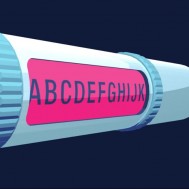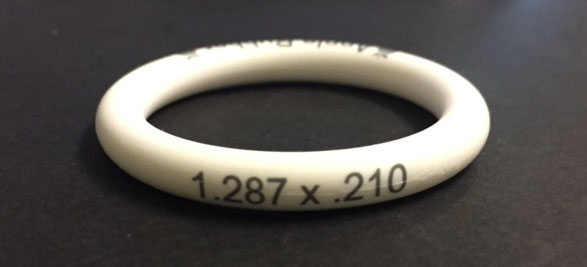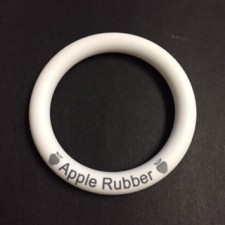Previously, when manufacturers had to mark a surface with a pattern such as a barcode, image or text, they had to choose between traditional engraving or screen printing. These processes, though, were costly, nonpermanent and often damaged parts.
With the implementation of laser marking, though, engineers are able to create characters, numbers or images without compromising the parts. Instead of using a physical tool to etch the surface or transmit ink, this process uses focused laser light to produce damage-free, easy-to-read marks.
Laser marking has become an essential part of the manufacturing industry — helping businesses keep track of their products, improve quality, minimize counterfeiting and more. To help understand the potential behind this technology, we’ve laid out the benefits of laser marking in manufacturing.
The process is clean and eco-friendly.
Other marking processes, such as inkjet or chemical etching, use inks and chemicals in their marking — which not only are expensive consumables for the business, but have a negative effect on the environment. Laser marking, on the other hand, does not use any consumables — making is clean, affordable and energy efficient.
It also eliminates costs and downtime associated with cleaning, fixing or powering printers. While labels can peel off or become damaged over time, laser marking, provides permanent identification for parts and does not have to be performed multiple times.
Because the process is non-contact, laser marking ensures clean processing with minimal contamination. Where printing systems will burn down the material by marking, the damage-free process involves minimal or no material penetration.
Laser marking helps manufacturers comply with federal law.
Many federal groups require some sort of identification to comply with laws that uphold quality, traceability and other safety standards. Automotive companies, for example, use part traceability to quickly determine when and where a part was produced in the case of a component failure — aiding in recalls.
When it comes to the medical industry, the Food and Drug Administration requires all medical manufacturers to include a unique device identifier on devices labels and packages. This UDI is a unique code that consists of a device identifier, which identifies the labeler and the model/version, and a production identifier, which represents several parts such as expiration date, serial number and other codes.
Similarly, the Federal Aviation Administration requires aerospace engineers to include certain marking in propellers, engines and other parts. It’s up to the FAA to determine which markings are required on each part (such as model, builder and certification), but they must be marked with an approved fireproof method.
Laser marking can connect parts to the Industrial Internet of Things.
Another one of the benefits of laser marking is the ability to connect with the IIoT. Previously, large manufacturers with multiple laser marking machines would have to manually upload a new job each time there was a new order (which was a time-consuming and inefficient process). Mecco Marking and Traceability developed a system to meet the needs of smart manufacturers by streamlining this process – connecting automation and laser marking to the IIoT.
Mecco created a programmable logic controller that works as a smart board, allowing one factory manager to managing multiple jobs or automation lines simultaneously and remotely.
“Historically, marking systems have not been able to communicate directly with a PLC,” David Sweet, president of Mecco Marking & Traceability, explains. “It’s been a challenge for manufacturers who want to incorporate automated part marking into their processes. The Remote API—and its ability for bi-directional communication—is a key benefit for us. It has allowed us to do what we couldn’t do before: seamlessly connect our clients’ PLCs with their laser marking devices.”
It minimizes counterfeit products.
Counterfeiting has a huge impact on the global pharmaceutical industry — an epidemic that is not only illegal, but has many social and economic implications. It’s estimated that 10 percent of global pharmaceutical sales are counterfeit products. Not only has this cost the industry $16 billion, but it opens up a bridge for organized crime and terrorism.
Pharmaceutical manufacturers are limited in what type of marking they can use. The marking must be tamper-proof and easy to read, compatible with the environment and cannot alter the product. Because of this, the most viable solution is laser internal engraving — a similar process that leaves a laser mark you can both see and feel.
“The recent development of industrial-class ultrafast lasers enable internal marking without any damage to the container,” Eric Mottay of LIA Today says. “Because of the extremely high optical intensity and very short pulse duration delivered by ultrafast lasers, there is no heat dissipation during the interaction process, which means that there is no micro-crack formation. Therefore, since the individual spots can be made very small, it is also possible to achieve virtually invisible marking, and yet to guarantee reliable reading under proper lighting.”
Laser marking doesn’t compromise quality.
With laser marking, there is no need to etch a product or transmit ink onto the surface. Instead, laser light is focused onto a material to produce damage-free marks.
Here at Apple Rubber, we use Apple LaserMark, a Samurai UV Laser Marking System, to mark our parts. One benefit of this tool is its beam quality, which leads to a smaller spot size of the laser. The small spot size, along with short pulses, produces high peak power which is beneficial in deep marking with crisp, clear marks and small characters.
Laser marking in manufacturing: What’s next?
What benefits of laser marking in manufacturing have you found? What have you learned about the future of this technology? Let us know by tweeting us at @AppleRubber.


